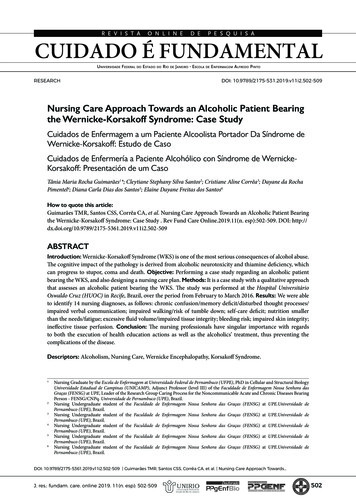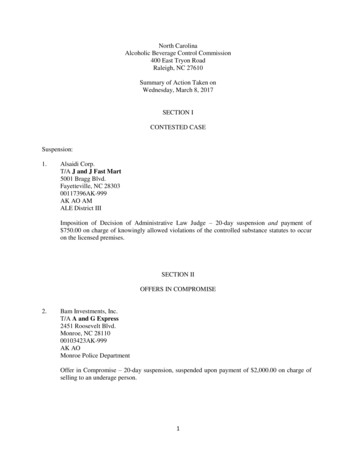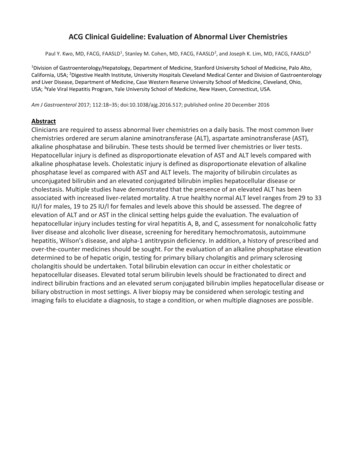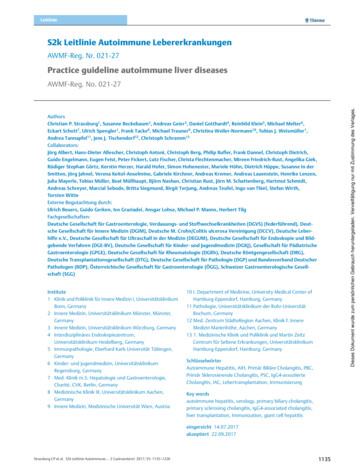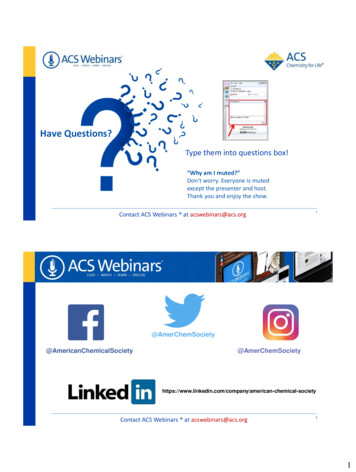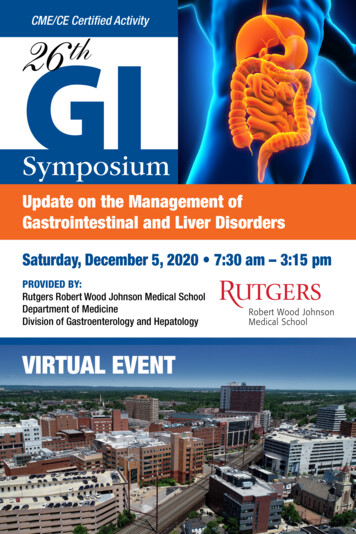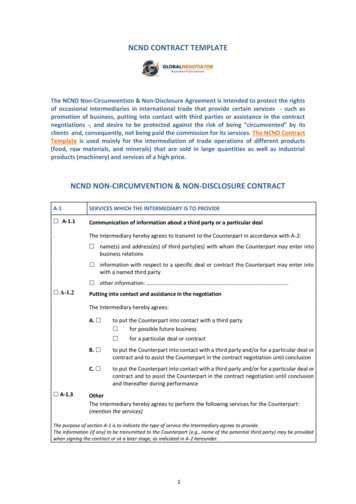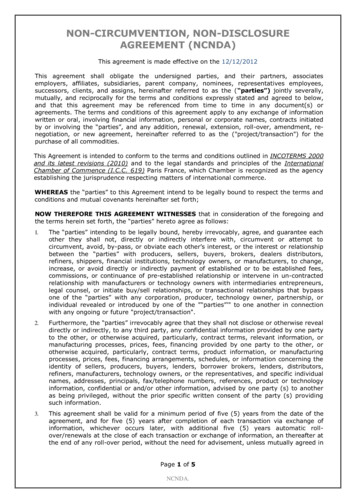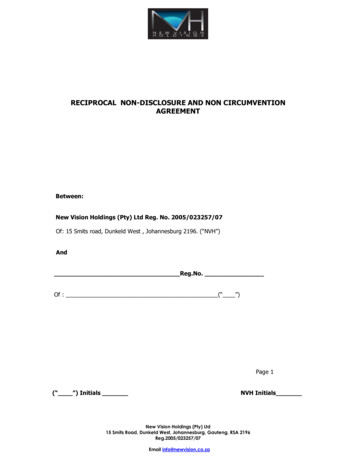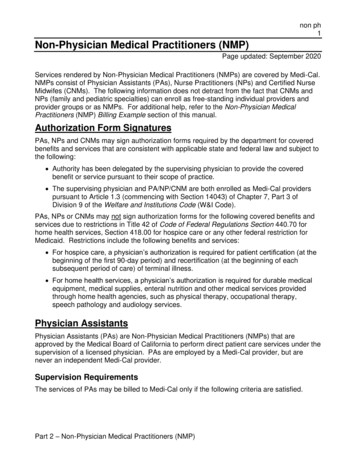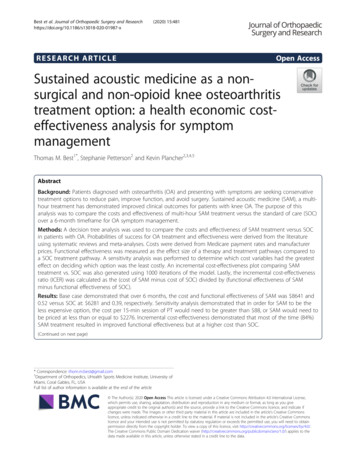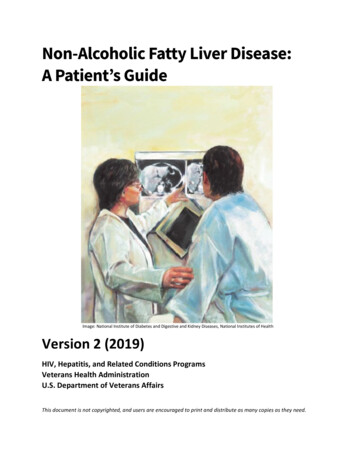
Transcription
Non-Alcoholic Fatty Liver Disease:A Patient’s GuideImage: National Institute of Diabetes and Digestive and Kidney Diseases, National Institutes of HealthVersion 2 (2019)HIV, Hepatitis, and Related Conditions ProgramsVeterans Health AdministrationU.S. Department of Veterans AffairsThis document is not copyrighted, and users are encouraged to print and distribute as many copies as they need.
ContentsTo our patients . 3The liver. 4What is the liver? . 4What does the liver do? . 4A sick liver?. 4Other things that can affect the liver. 4Lab tests for your liver . 5Names of the tests . 5The ALT/SGPT Test . 5The AST/SGOT test . 5The T. Bili. test . 5The Albumin test . 5The PT/INR test . 5Other lab tests. 5Non-alcoholic Fatty Liver Disease (NAFLD) . 6What is NAFLD?. 6What happens when you have NAFLD? . 6Who gets NAFLD? . 7How do I know if I have NAFLD? . 7What is a Liver Biopsy? . 7What are the symptoms of NAFLD?. 7What are my risk factors for NAFLD?. 8Liver cancer screening. 8Treatment/Prevention . 9How is NAFLD/NASH treated? . 9Physical Activity (Aerobic and Resistance). 9Diet changes. 9What diet changes can I make? . 9Weight loss . 10Medications to treat NAFLD. 11Controlling diabetes . 11Controlling cholesterol and fats . 112
Take care of your liver. 11Herbs to avoid . 11Making Smart Goals . 12Definitions . 14Resources . 15Contributers . 15To our patientsObesity is one of the leading causes of death world-wide and with this disease comes a series of medicalconditions. Non- Alcoholic Fatty Liver Disease (NAFLD) is one of the diseases associated with obesity.Currently, the goal of treatment is to reduce the risk factors associated with NAFLD. Awareness of thiscondition and lifestyle changes is key to changing the progression of the disease.Let the handbook guide you to ask your health care provider for more information about your situation.Sometimes the information provided during a clinic visit is much more than you can absorb right away.You may forget to ask what is most important to you or you may think of a question later.We hope you will read this handbook and share it with family, friends and your other health careproviders.3
The liverWhat is the liver?Your liver is one of the largest organs in your body. Your liver is located in the upper right-hand part ofyour abdomen and is protected by your ribs. A healthy liver is reddish-brown in color.What does the liver do?Your liver works behind the scenes performing over 500functions! The liver acts like a factory and a filter in thefollowing ways: Processes and stores vitamins, sugars, fats andother nutrients from the food you eatMakes substances that your body needs to stayhealthyo Albumin: protein made by liverA healthy livero Bile: digestive juice which helps the bodyabsorb fat from the gut to the bloodstreamBreaks down harmful products, such as alcohol and toxinsRemoves some wastes from your bloodChanges extra glucose (energy) into glycogen (energy storage). Glycogen can be changed back toglucose when your body needs extra energyHelps with blood clottingA sick liver?When the liver does not work well, you can get very sick, oreven die if your liver stops working.When the liver does get injured, one of the earliest ways wecan tell is by blood tests that show high levels of liverenzymes in the blood, and sometimes by yellowing of theskin, known as jaundice.A sick liverOther things that can affect the liver Virus (hepatitis A, B, C, D)AlcoholLiver CancerObesityPrescription DrugsStreet DrugsTobaccoOver-the-counter drugs4
Lab tests for your liverWhen trying to determine the health of your liver, your health care provider will order lab tests that cangive information about whether your liver has been damaged.Names of the testsThe most common tests that are used to check how well your liver is working are called the LiverFunction Tests (LFTs) and Liver Enzymes.The most common tests are: Alanine Aminotransferase (ALT/SGPT)Aspartate Aminotransferase (AST/SGOT)Total Bilirubin (T.Bili)AlbuminProthrombin Time/ International Normalized Ratio (PT/INR)The ALT/SGPT TestThis is an enzyme made in liver cells. If the cells in the liver are damaged, ALT enzymes are released intothe bloodstream and result in higher ALT levels. ALT levels can vary and do NOT always reflect thedegree of liver cell damage nor do they assess actual function of the liver.The AST/SGOT testThis enzyme, much like ALT is made in liver cells. High levels of AST can indicate liver injury. However,factors not related to liver disease can cause higher AST levels, such as other illnesses, muscle or heartinjury or certain medications.The T. Bili. testBilirubin is the yellow breakdown product of heme which isfound in hemoglobin. Bilirubin is removed from the blood bythe liver, but when the liver is not working well, bilirubin levelscan rise. High levels of bilirubin suggest the liver is not workingwell. Signs of high levels of bilirubin include yellowing of theskin and whites of the eyes (called jaundice).Jaundice: Yellowing of the eyes and skinThe Albumin testAlbumin is a protein made only in the liver. If the amount of albumin is low, it suggests that the livermay not be working well.The PT/INR testThis test measures how well your blood clots. If the prothrombin time is high, it may mean that the livercannot produce enough of the clotting proteins.Other lab testsYour provider may order other tests. It is important to keep in mind that just because you may haveabnormal levels of an enzyme on a test, it does not mean you liver is failing. Also, liver enzymes may benormal sometimes in patients who have liver disease. Your provider will interpret these tests and workwith you.5
Non-alcoholic Fatty Liver Disease (NAFLD)What is NAFLD?NAFLD is the most common cause of chronic liver disease in the U.S.It is due to the buildup of fat in the liver not caused by an overuse of alcohol. Fatty liver (steatosis)occurs when the liver has more than 5-10% of its weight in fat. NAFLD is related to obesity, diabetes andoften abnormal levels of fat in the blood and high blood pressure.Fatty liver in isolation does not damage the liver, however nonalcoholic steatohepatitis (NASH) which isa severe form of NAFLD can cause inflammation and damage to the liver.This can progress to scarring or fibrosis in the liver and, in some patients, cirrhosis where hard scartissue develops in the entire liver. This process usually takes several years or even decades to develop.Image: National Institute of Diabetes and Digestive and Kidney Diseases, National Institutes of HealthWhat happens when you have NAFLD?Fatty Liver: Fat enters the liver cell. Next the cell swells and changes which causes liver injury.NASH: A bad case of liver injury which has inflammation and swelling of liver cells and can progress tocirrhosis or severe scarring of the liver. Not everyone with NASH will develop cirrhosis.Cirrhosis: A scarred liver from years of damage.6
Who gets NAFLD? 20-30% of Americans have NAFLD2-5% of Americans have NASHOccurs in both males and femalesAdults and children (less common in children)All ethnic groups (commonest in Hispanics)Found in 80% of obese individuals, particularly those with large waist sizesIncreased in individuals with type 2 diabetesIncreased in individuals with high blood pressureIncrease in individuals with high amount of fats called triglycerides in the blood or low levels ofgood cholesterol called HDLIncreased in individuals with obstructive sleep apneaHow do I know if I have NAFLD?Routine blood tests your health care provider (increased levels of liver enzymes) ordered may lead totesting that shows fatty liver disease.Fatty liver can also be seen sometimes on X rays (ultrasounds, CT or MRI) of your abdomen where theradiologist notices fat in the liver.Additional testing may be required to eliminate other possible causes of the high blood tests andabnormal X-rays.Some individuals who have fatty liver seen on X-rays may have completely normal liver enzymes.Your health care provider may order more accurate ultrasound, computed tomography (CT) scan ormagnetic resonance imaging (MRI) scans which can show a presence of fat in the liver or fatty liver.A new type of ultrasound based test called elastography (Fibroscan) may be ordered to look for scarringin the liver.The diagnosis of fatty liver versus NASH is often done by liver biopsy.What is a Liver Biopsy?A liver biopsy is a simple procedure where a doctor places a needle through your skin into the liver toget some cells. The cells are then sent to the lab to be looked at under a microscope.What are the symptoms of NAFLD?Non-alcoholic Fatty Liver Disease can be considered a silent disease in which the person may not noticeany symptoms.Symptoms may be divided in the following categories: Early Symptoms:o None7
o Feeling tired / Fatigueo Pain in right upper abdomenLate Symptoms:o Weight losso Fluid in the abdomen (Ascites)o Yellowing of skin (Jaundice)o ItchinessOther Symptoms:o Enlarged livero ObesityAscites: fluid in the abdomenWhat are my risk factors for NAFLD?The cause of NAFLD is not completely known, however NAFLD can take years to develop. NAFLD occursmost often in people with the following: Central obesity (around your abdomen)Non-insulin dependent diabetesInsulin resistance (cells in the body do not respond to insulin)Dyslipidemia (fats found in blood which are needed for health, but sometimes becomeabnormal)o High triglycerides (a fatty substance in the blood)o High LDL (bad cholesterol)o Low HDL (good cholesterol)If more than one of the above risk factors are present than you may have metabolic syndrome.Metabolic syndrome is associated with a higher risk of developing NAFLD.Less common risk factors: Rapid and excessive weight lossPoor diet and exercise habitsMiddle age (but can be found in children)Family or personal historyPolycystic Ovary Syndrome (PCOS) is a health problem that can affect a woman's menstrualcycle, ability to have children, hormones, heart, blood vessels, and appearanceObstructive sleep apneaGrowth hormone deficiencyLiver cancer screeningPeople with cirrhosis are considered to be at increased risk of liver cancer (hepatocellular carcinoma orHCC). In the setting of cirrhosis, screening for liver cancer is generally recommended. A commonrecommendation is to perform an ultrasound of the liver and a blood test called Alpha-fetoprotein (AFP)for screening every 6 months.In patient with cirrhosis due to NAFLD, screening for liver cancer is recommended as well. If you havecirrhosis please discuss screening for liver cancer with your health care provider.8
Treatment/PreventionHow is NAFLD/NASH treated?The most important treatment for NAFLD/NASH is weight loss done gradually and through acombination of healthy diet changes and regular exercise.The amount of weight loss that can reverse NAFLD is around 7-10% of total body weight. The goal is tolose weight slowly and gradually (1-2 lbs. per week) to achieve this goal over a year.Lifestyle Changes: Key factor in treatment Physical Activity (Aerobic and Resistance)Diet ChangesWeight Loss (MOVE! Program)Physical Activity (Aerobic and Resistance)Increasing physical activity through aerobic andresistance type activities reduce risk factors. Alwayscheck with your provider before beginning an exerciseroutine.If you aren’t used to exercising start small and increase as tolerated.Goal: 30 minutes of exercise 5 days per weekFind ways to add more activity in your day: Take the stairs instead of the elevatorPark further away at the grocery storeKeep an exercise journal to track your progressDiet changesGood nutrition is part of an effective treatment for NAFLD.What diet changes can I make? Eat breakfast dailyo Breakfast gives you energy to start the dayo A healthy breakfast is important for everyoneWatch portion sizes to manage your calorie intakeo Using smaller plates, bowls and glasses can help you keep your portions under controlEat a diet rich in fruits and vegetableso Make fruits and vegetables cover at least half of your plateo Add fruits and vegetables to snackso Aim for 2 1/2 cups of vegetables and 2 cups of fruit dailyo Reduce the amount of sugar and starch in your diet Reduce the amount of white bread, pasta, potatoes, rice Reduce or eliminate sugary beverages including sodas, juices and by notsweetening tea or coffee9
oooReduce the amount of saturated fat in your diet Select lean cuts of meat and low-fat dairy products Switch to oils when preparing food Select healthy unsaturated fats, such as those found in fish, olive oil and nutsMake at least half your grain servings whole grains Choose whole grain breads and cereals, brown rice and whole wheat pastaKeep a food journal to track your progressWeight lossWeight loss is important in the treatment of NAFLD. However, too rapid of a loss can lead to worseningliver function. It is recommended that you aim for 7-10% loss of body weight over 6 to 12 months ofgradual weight loss not exceeding 2 pounds/week. Rapid weight loss may place you at risk forprogression of liver disease and liver scarring.MOVE! Weight Management ProgramMOVE! Weight Management Program is a national VA program designed by the VA National Center forHealth Promotion and Disease Prevention (NCP). MOVE! has helped thousands of Veterans lose weight.All VA Medical Centers and many VA Community-based Outpatient Clinics (CBOCs) offer MOVE!. Contactthe nearest VA facility to inquire about program availability. Veterans receiving care from VA can enrollin the MOVE! Program. However, the MOVE!11 questionnaire can be taken by anyone. MOVE! optionsof care for Veterans includes: MOVE! Group Sessions has the greatest evidence for success and is the most common wayVeterans participate in MOVE! Time-limited, clinician-led groups meet regularly and follow astructured format for weight loss. To enable more Veterans to participate, many medicalcenters provide video conferencing to community-based outpatient facilities (CBOCs), as well aslong-term groups for weight maintenance.MOVE! Telephone Lifestyle Coaching is for Veterans who prefer one-on-one contact viatelephone with a designated weight management coach.TeleMOVE! is for Veterans who may benefit from frequent reminders to stay on track with theirweight management goals. This includes daily interaction with in-home messaging technologiesand clinician contact as needed.MOVE! Coach is a mobile app for Veterans who prefer to manage their weight on their own.Brief check-ins with a MOVE! clinician may be available at VA facilities that offer MOVE! Coachwith Care. Simply go to the App Store on any iOS device (version 6.0 or higher) and downloadthe app now! Development of an Android version of MOVE! Coach is underway.Weight Loss Medications and Bariatric Surgery are treatment options that may be offered toVeterans who have tried MOVE! but continue to struggle with overweight or weight-relatedissues.Get started with MOVE!1. Let your VA Primary Care team know that you are interested in MOVE!2. Complete the MOVE!11 Getting Started Questionnaire at your local VA or online.10
3. Print and review your MOVE!11 Getting Started Questionnaire report with your team who willhelp you set some initial goals. This report will also recommend MOVE! Handouts specific toyour needs.4. With your team's guidance, choose from the MOVE! Treatment Options available at your facility.Medications to treat NAFLDCurrently there no medications that are approved by the FDA specifically to treat NAFLD/NASH althoughthere are many medications that are being tested in research studies for NASH.Medications which have been shown in small studies to help some patients with NASH include:Vitamin E. This is an anti-oxidant that in a small study showed improvement in liver inflammation andliver cell swelling due to NASH. This medication has potential side effects and is not for everyone. Yourliver specialist may perform a liver biopsy to show that you have NASH if they are considering using thismedication and they will also evaluate your risk for side effects.Controlling diabetesMonitoring blood sugar, following a healthy diet and working with your provider if you needmedications to control diabetes will help keep your liver healthy.Controlling cholesterol and fatsLimit your intake of saturated fats, (red meat, fried/oily food, butter, shortening, milk and dairy products(except fat-free versions).Replace them with monounsaturated fats (olive, canola, oil) and polyunsaturated fat found in oily fishsuch as salmon, flaxseed oil, and walnuts.Healthy eating combined with exercise – and taking cholesterol-lowering medications if prescribed byyour provider – will help keep your cholesterol and (fat) triglyceride levels where they need to be.Take care of your liverDo not drink alcohol if you have NASH, abnormal liver enzymes or have hepatitis B or C.Before taking any medications including over the counter and herbal medications discuss with yourhealth care provider.Physical activity is important in treating fatty liver.Eat a balanced diet low in saturated fats and high in fiber.Keep your cholesterol, blood pressure and blood sugar under control.If you have a question, ASK!Herbs to avoidIf you are curious about alternative and complementary therapies, then you should ask your health careprovider whether it would be safe for you to try them.11
The herbs listed below are known to be dangerous, which means that they are bad for your liver,especially since you have liver disease. ArtemisiaAtractylis gummiferaBush teaCallilepis laureolaChaparral leaf (creosote bush, greasewood)Comfrey (Symphytum officinale)CrotalariaGermanderGordolobo yerba teaGreen tea extractHeliotropiumJin-Bu-HuangKavaKombucha mushroom (tea)Ma-Huang (Ephedra sinica)Margosa oilMistletoePennyroyal (squaw mint oil)Tansy Ragwort (variation of Ragwort)SassafrasSenecio aureusSennaSkullcapSymphytumValerian rootMaking Smart GoalsA healthy living goal is something YOU want to do to improve your health or well-being. Chances are youhave set and met many goals in life already.Setting clearly defined goals can be helpful in making a difficult lifestyle change, such as quitting drinkingor losing weight. Try the steps below: My goal for next week is: (Be specific: what, where, how much, and how often) Example: I willwalk at least 3 times this week for 15 minutes after I get home from work.Things that might get in my way: (Examples: weather, pain, time)What I can do to overcome these things: (Examples: exercise indoors, walk with a friend)I believe that I can reach my goal: (Circle the number that matches how confident you feel).12
Keep Track of your progress and let us know how you are doing:If you met your goal, terrific!If you had trouble, re-work your goal so you can succeed13
DefinitionsAerobic Exercise: Type of exercise that requires oxygen and gets your heart pumping.Ascites: Fluid in the belly.Cholesterol: A fat substance that is found in the bodies of people and animals. Too much cholesterol inyour body may cause heart disease.Cirrhosis: Scarring of the whole liver which makes the liver shrunken and hard. Cirrhosis is the result ofsomething that damages the liver for a long time.CT Scan (CAT Scan): A type of X-ray that takes pictures of parts of your body from many angles. Often adye is used to make the target body part easier to see.Enzymes: A chemical substance in animals and plants that helps to cause natural processes (such asdigestion). Helps chemical changes to take place in the plant or animals.Glucose: The main type of sugar in the blood and is the major source of energy for the body’s cells.Glucose comes from the foods we eat or the body can make it.Glycogen: Energy stored in the liver and muscle. The body uses this energy when needed.HDL (Good Cholesterol): A type of cholesterol that carries bad cholesterol (LDL) away from your arteriesand back to your liver, helping to protect you against heart disease.Hormones: A natural substance that is produced in the body and that influences the way the bodygrows or develops. A chemical substance produced by your body that influences its growth,development, and condition.Inflammation: A condition in which a part of your body becomes red, swollen, painful and feels hot.Insulin: A hormone released by the pancreas whose job is to help use or store glucose as glycogen.Jaundice: When your eyes and skin turn yellow. It is a sign that the liver is not working well. You can alsobecome jaundiced if your bile ducts are blocked.LDL (Bad Cholesterol): A type of cholesterol that can turn into a hard substance which can stop yourblood flowing properly and can eventually cause heart disease.Metabolic Syndrome: A medical condition characterized by obesity, insulin resistance, hypertension anddyslipidemia.MRI: A test that takes pictures of a body part using a magnet, radio waves and a computer.Pancreas: A large gland of the body that is near the stomach and that produces insulin and othersubstances that help the body digest food.PCOS: Polycystic Ovary Syndrome (PCOS) is a health problem that can affect a woman's menstrual cycle,ability to have children, hormones, heart, blood vessels, and appearance.Resistance Exercise: Type of exercise which includes weight lifting.14
Saturated Fats: A type of fat commonly found in animal products that is thought to be less healthy thanother kinds of fat from vegetable oils or fish.Steatosis: Abnormal buildup of fat in the liver.Steatohepatitis: A form of inflammation in the liver in which there is a buildup of fat in the liver.Symptoms: A change in the body or mind which could show that a disease is present.Treatment: Something that is done to help someone who is injured or ill.Triglycerides: One of the main fatty substances in the blood that can clog arteries.Ultrasound (U/S): A type of test that uses sound waves to take pictures of parts of the body.Unsaturated Fats: A type of fat found in food such as nuts, seeds, avocados, and fish.ResourcesMOVE! website: www.move.va.govHealthy eating tips: www.choosemyplate.govAmerican Liver Foundation: www.liverfoundation.orgDiabetes website: www.diabetes.orgVHA National Center for Health Promotion and Disease Prevention: www.prevention.va.govHealthfinder: www.healthfinder.govVA’s Viral Hepatitis Program www.hepatitis.va.gov (Other handouts found on this website): NAFLD Fact SheetCirrhosis: A Patient GuideLiver Transplant GuideLiver Cancer GuideContributersUpdated Version: Adnan Said, MD, MS; Heather McCurdy, MSN, NP-COriginal Version: The William S. Middleton Memorial Veterans Hospital: Adnan Said, MD, MS, Chief ofGastroenterology and Hepatology; Michelle Lisowski, DNP, RN, APNP (Gastroenterology/Hepatology);Heidi Bolling, MS, RN, APN-C (Chief Ambulatory Care Nursing); Kathy Keckeisen, MS, RN, APNP (HealthPromotion Disease Prevention Manager); Kristen McCaskey, RD, CD (Clinical Dietitian, MOVE! ProgramCoordinator)15
When the liver does not work well, you can get very sick, or even die if your liver stops working. When the liver does get injured, one of the earliest ways we can tell is by blood tests that show high levels of liver enzymes in the blood, and sometimes by yellowing of the skin,
